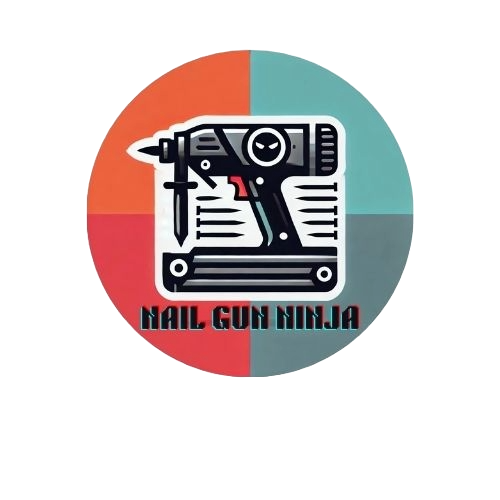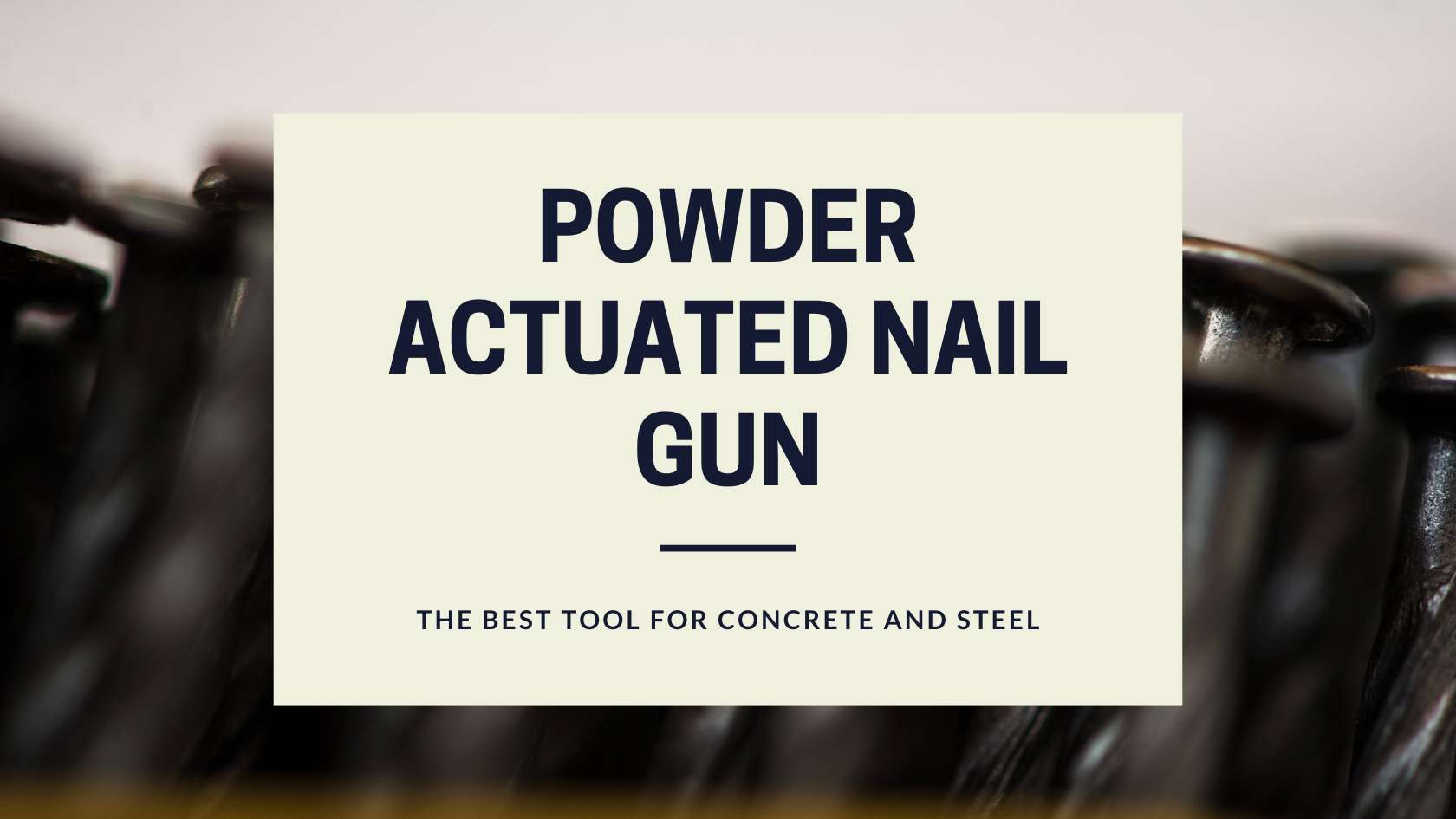If you plan to secure a steel frame onto a concrete foundation, traditional tools like hammers won’t cut it. In this case, the powder actuated nail gun comes in. It is a powerful fastening tool often compared to a firearm.
It is a specialized nail gun, that not everyone knows about. In this article, I will explore all about powder-actuated nailers.
What Is a Powder Actuated Nail Gun?
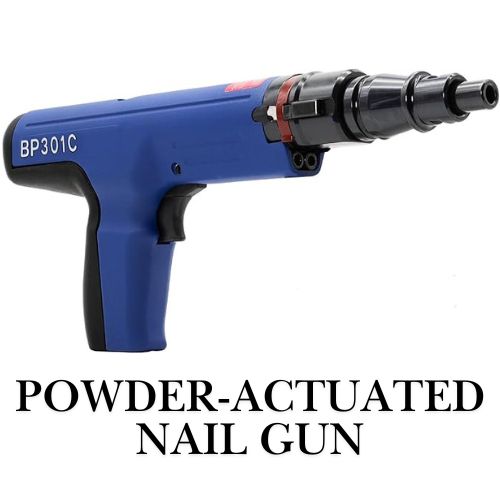
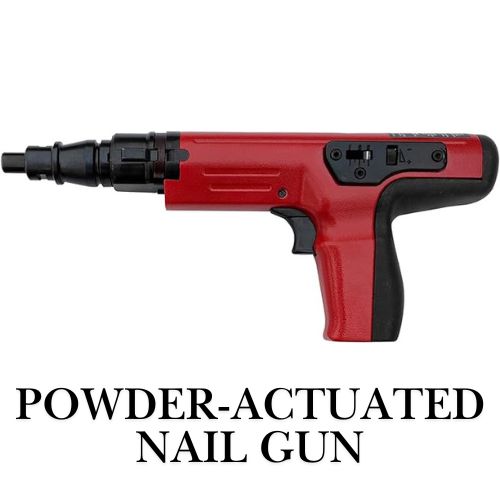
A powder actuated nailer is a specialized nailing tool known as a PAT gun. It is often referred to as a stud gun or Ramset. it is used to drive nails into hard materials like concrete, steel, or masonry.
The term “powder actuated” means the tool’s operating mechanism depends on gunpowder or a similar combustible powder charge to generate force. Like firearm ammunition, this nailer uses a small cartridge filled with powder as a power source.
How Does a Powder Actuated Nailer Work?
Powder-actuated nailers are driven by a controlled explosion of a small chemical propellant charge to create the required force to drive the nails into the substrate. It produces explosive energy to shoot nails into hard materials.
Here’s a step-by-step process regarding power-actuated nailing gus operation:
- Cartridge Loading: Place the explosive charge into the nail gun.
- Tool Positioning: Aim the nail gun at the required fastening point.
- Trigger Applying: Pull the trigger to fire the cartridge, producing explosive force.
- Fastener Driving: The force propels the nails onto the surface.
Types of Powder Actuated Nailer Guns
Powder-actuated nailer guns come in two main types depending on their operation mechanism and the activation of power load.
One is direct-acting (High velocity) and the other is indirect-acting (Low velocity).
Direct-Acting (High-Velocity)
- The powder charge directly drives the fasteners into the material in direct-acting.
- They are more powerful tools generally used for heavy-duty applications such as structural components to hard surfaces like concrete or steel.
- They come with high-velocity
- Their application is heavily regulated for safety.
Indirect-Acting (Low-Velocity)
- In the case of indirect-acting powder-actuated nail guns, the powder charge drives a piston, which in turn drives the nails or fasteners into the materials.
- This type of powder actuated nailer uses the piston to minimize the velocity of the fasteners.
- They are ideal for a broader range of applications like general construction projects.
- Because of piston use, they come with low velocity.
- They are comparatively safer than the direct-acting type.
Types of Powder Actuated Nails
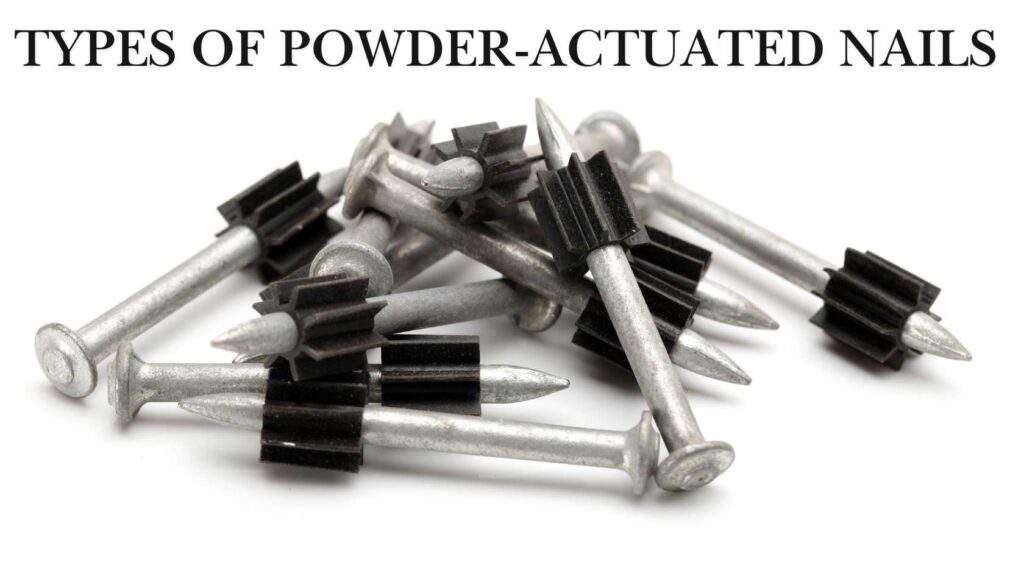
Powder-actuated nails are commonly called fasteners. They are available in various types focusing on their design, purpose, and applications. The types can be categorized broadly.
Let’s discuss the types of nails operated by PATs:
Smooth Shank Nails
- Basic nails that come with a smooth shaft. No additional texture.
- Perfect for general or light-duty applications, where less holding power is required.
- It can fasten materials like wood to concrete or steel.
Knurled Shank Nails
- These shank nails have a knurled or ridged texture. It improves grip and holding power.
- Best for fastening into softer materials like lightweight concrete or thin sheet metals.
- The knurled surface creates additional friction between the fasteners and the materials used in the project.
- Generally made of steel, stainless steel, or other durable metals.
- Some may be coated such as galvanized knurled nails for corrosion resistance.
Threaded Shank Nails
- Specialized fasteners with spiral or helical threads.
- Creates a screw-like grip in the material.
- It is generally made from steel, stainless steel, or other durable metals.
- Sometimes available with coatings like galvanized nails to resist corrosion in moisture.
- Often applied with anchors for attaching items to concrete or brick.
- High holding power because of the threads.
Fluted Shank Nails
- Specialized fasteners with longitudinal grooves or flutes running along their shank.
- This unique design increases their holding power.
- Best for hard surfaces like dense concrete, steel, or non-pliable materials.
- It is generally made of hardened steel or stainless steel.
- Pated or coated for corrosion resistance.
Washered Nails
- Washered nails are nails that include an attached or separate washer at the base of the fastener head.
- These nails serve as a supplementary support mechanism.
- Distributes force in a balanced manner.
- Reduces the damage to materials.
- Securing thin steel sheets, insulation, or other compressible materials for various applications.
Hardened Steel Nails
- These hardened steel nails are made from high-carbon steel that has been hardened.
- This process increases their strength, durability, and resistance to abstain from bending or breaking.
- They are coated with galvanization for corrosion resistance. Moreover, Some have additional coatings, such as vinyl.
- They are best for concrete fastening, and hardwood projects like attaching furniture or flooring.
- They are applicable even in high-stress environments.
Specialty Nails
- Ballistic point fasteners. They come with a sharp point that penetrates hard materials easily.
- Rebar pins are used to attach wood or metal to rebar in concrete construction.
Pros & Cons of Powder Actuated Concrete Nailer
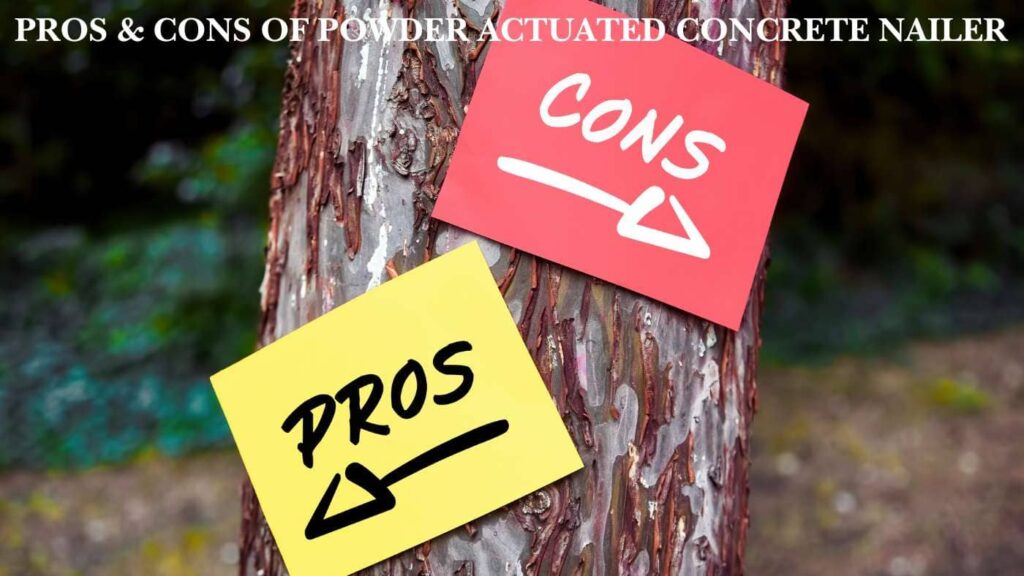
Here, I have described every pros and cons of powder-actuated nail guns:
Pros
Power Level
Powder-actuated gun nails penetrate nails into very tough materials like concrete or steel easily and efficiently. They save significant time and effort compared to manual methods like hammering.
No Air Compressor or Electricity
You can operate this tool without an air compressor, air hoses, or electricity. Offers great portability and freedom to move to work sites.
Less Effort
You can avoid hammering and decrease the physical strain using this tool.
Versatile
You can use them in a variety of environments and on different materials like concrete, steel, and brick. This tool is enough versatile, especially for construction professionals.
Accuracy & Precision
Powder-actuated nailers deliver a high degree of precision. You can use this nail gun to drive nails in the correct location with less effort.
Cons
Safety Concerns
Powder-actuated tools like nail guns are involved in an explosive mechanism. So, if you do not handle it properly, it may lead to dangerous accidents, like nail misfires or accidental nail discharges. Proper nail gun training is required.
Cost
These nail guns are slightly more expensive than traditional pneumatic or electric nail guns. That’s why these tools are less appealing for casual or DIYers. But their cost always depends on their brand, model, and features.
Limited Fastener Range
The fasteners used in this nail gun are generally limited to specific sizes. They are not best for every type of material or project.
Legal Restrictions
In some areas, powder-actuated nailer gun users need to follow some legal and regulatory instructions. Users may require special licensing or permits to operate this power tool.
Noise & Vibration
The explosive charge produces loud noise and vibration. Significant noise and vibration can be uncomfortable. They also require hearing protection on job sites.
Key Features of Powder Actuated Nail Gun for Steel
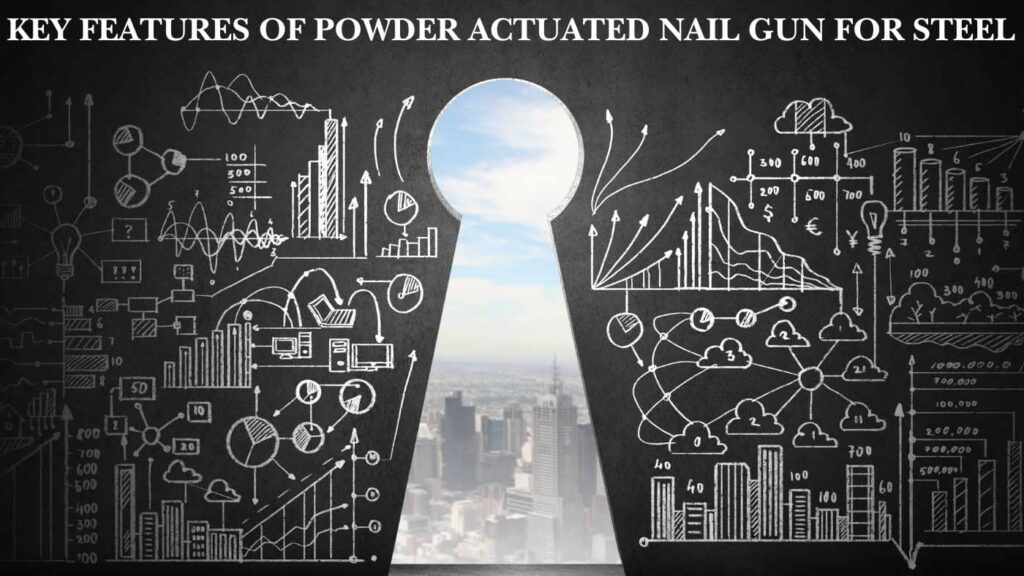
This specialized nail gun comes with some exceptional features. These features have made this power tool unique from other nail guns available in the tool industry. So, I think it is very important to showcase the core features of this gun nailer.
Here are the key features of powder-actuated gun nailers:
Power Sources
Powder-actuated nailers are applied by explosive charges (powder cartridges) to generate force. Powder cartridges are used as the power source of this nail gun.
Fastening Capability
They are specially designed for heavy-duty fastening tasks, that can drive nails into dense, non-wood surfaces, like concrete, steel, or brick.
Cartridges and Load Levels
Allows the users to select color-coded powder cartridges that vary in strength. It ensures matching the materials and fastening needs. Users choose an appropriate load level for different projects and materials.
Material Compatibility
Powder-actuated nailers are exceptionally suitable for concrete, steel, brick, and other extremely tough surfaces. They are used in structural applications like attaching wood framing to concrete or steel beams.
Fasteners or Nails
Use specialized nails or fasteners to penetrate hard materials. Fasteners are heat-treated to provide additional strength and durability.
Durability
Powder actuated nails deliver a reliable and durable finish in heavy-duty construction projects.
Precision
Ensures accurate placement in stiff materials with less effort. Some models often offer adjustable depth settings to achieve the desired fastening depth.
Licensing
PAT or powder-actuated tool users need a license or special certification to operate. Workers might go through a training and certification process before using powder-actuated tools.
Uses of Powder Actuated Nailer
Here are some common applications of powder-actuated nailers:
Concrete and Steel Work
Powder-actuated nailers are mainly applied in construction for attaching materials like wood or metal to concrete or steel surfaces. They are useful in tasks like framing or installing furring strips.
Structural Work
A powder-actuated nailer is an efficient tool For heavy-duty works, like anchoring steel studs, base plates, or other structural components. This tool speeds up the nailing process compared to traditional methods.
Construction & Renovation
They are useful in both new construction and renovation projects where fasteners are required to penetrate hard material surfaces, like walls, floors, and ceilings made of concrete or masonry.
Electrical & Plumbing
These nail guns are used for installing electrical boxes, conduits, or other items that need to be fixed into concrete, brick, or steel surfaces.
Flooring Installation
PAT nail guns are often used to secure subflooring to concrete or steel in areas like warehouses, workshops, factories, or other industrial spaces.
Bridge and Highway Construction
These nailers can be applied in various infrastructure projects like bridges, highways, or roadways since they are ideal for materials like concrete or steel components.
Industrial Applications
Powder-actuated nailing guns are ideal for various industrial settings where high-strength fastening is needed on thick, stiff materials.
Do I Need Powder Actuated Nail Gun License?
Yes, you need a license or special certification to operate a powder-actuated nailer in many areas. Specially PAT tools users need to have legal licenses.
These power tools use a small explosive charge to shoot nails into hard materials like concrete or steel, which makes them more hazardous than other nail guns. That’s why you need a PAT tool license.
For example, in the U.S., some states, boroughs, or cities require workers to go through training and certification before using these tools.
Moreover, the Occupational Safety and Health Administration (OSHA) insists on proper training for workers who use these tools in certain industries. In the training, users will learn the effective way of using nail guns.
If you want to use a powder-actuated nailer, it’s a good idea to:
- Check Local Regulations: Try to figure out if a license or certification is needed in your certain area.
- Take a Training Course: Many manufacturers and tool safety organizations launch training programs. You will learn how to operate nail guns properly.
- Follow Safety Protocols: Always abide by the nail gun safety checklists as well as ensure best practices when using these tools.
Key Components of Powder Actuated Nailer
Here are the core components of a powder-actuated nailer gun. Without these components a powder-actuated nailer is nothing.
Cartridge Chamber
This component holds the powder charge or shell that, when ignited, shoots the nail. This is the place of the tool where you load the powder cartridge.
Powder Cartridge
It is a small, sealed round shell that contains the propellant powder. When fired, it ignites to generate gas pressure to shoot the fastener.
Magazine
It is the component where you insert the nails or pins. This component is adjustable based on the length of the nails used.
Firing Pin
It is a spring-loaded mechanism to strike the powder cartridge when the trigger is pulled.
Trigger
The part of the nail gun that is used to drive nails. In this place, you keep your finger and push it inside to activate the firing pin and fire the powder cartridge.
Barrel
It is a long, tube-like component. The nails are driven into the target point through this barrel.
Power Adjustment Setting
Some models or brands allow users to adjust the power of the shot based on the material. It ensures proper penetration. It will prevent nail overdriving.
Exhaust Port
Releases the pressure and fumes produced from the cartridge ignition. It is located in the front or side of the nail gun.
Maintenance Tips for Powder Actuated Concrete Nail Gun
If you maintain any tool it will deliver you good output in the long run. Also, maintaining a powder-actuated nailer is crucial for ensuring its longevity and effective performance.
Here are some maintenance tips for the PAT users:
- Always clean the powder-actuated gun nailers after each use to avoid dust, dirt, and debris.
- Ensure that the barrel, firing pin, and piston are free of dust and debris to ensure smooth firing.
- Use lubrications like oil, that are designed specifically for powder-actuated nailers. Follow the manufacturer’s instructions for lubrication time and process.
- Daily inspect the O-rings for wear and tear. If any rings get damaged or cracked, replace them properly.
- Check the firing pin properly. A damaged firing pin may lead to nail misfires. Might damage the nail gun also.
- Monitor the cartridge chamber regularly to avoid misfires or less power.
- Regularly check the safety functions to ensure safe and sound operation.
- Store your powder-actuated nailers securely, in a dry, cool place. You can apply innovative nail gun storage ideas to store them properly.
- Only use the manufacturer-approved fuel. The wrong use of powder or cartridges affects the performance and also damages the nail gun.
My Final Words
Powder actuated nail gun is a specialized tool, that excels your nailing projects on hard materials. You may have other nail guns or hammers, but you can’t forcibly apply them to hard materials like concrete and steel.
So, if you or people around you, plan to work on heavy-duty projects with stiff materials, then you can suggest powder-actuated nailers without any hesitation.
FAQs
1. How to Remove Powder Actuated Nails?
Ans: To remove powder-actuated nails, first you need to figure out if the nail head is accessible or if the nail head is broken.
If the nail head is accessible take a pry bar, nail puller, or locking pliers to grip and pull the nail. If the nail head is broken or recessed, drill around the nail to loosen it first or apply an angle grinder to cut the nail flush with the surface.
If removal is not possible, then penetrate the nail deeper with a punch or hammer. If you are successful in removing the nails then repair the holes with wood filler or concrete patch.
2. Are powder-actuated tools legal?
Ans: Yes, powder-actuated tools (PAT tools) are legal in many areas, but their application is regulated because of the potential risks. These tools use a small explosive charge, that might be hazardous to the environment.
That’s why you need legality, especially in some states or regions of the U.S. you need a license and training certification to obtain legality.
3. What are the hazards of powder-actuated nailer guns?
Ans: Powder-actuated gun nailers come with some common risks and hazards like accidental nail discharge, strong recoil kickback, flying debris(Risky for eyes), over-penetration, or ricochet. Moreover, they cause hearing damage from loud noise.
4. In what materials powder-actuated nail guns should not be used?
Ans: powder-actuated gun nailers should not be applied on soft materials like wood or drywall, and brittle materials like glass, ceramic, or tile. Thin metal and weak concrete are not suited for this nail gun. Moreover, unbacked surfaces enhance the risk of ricochets.
